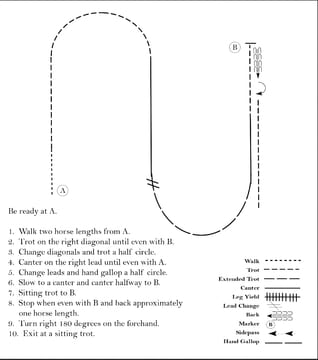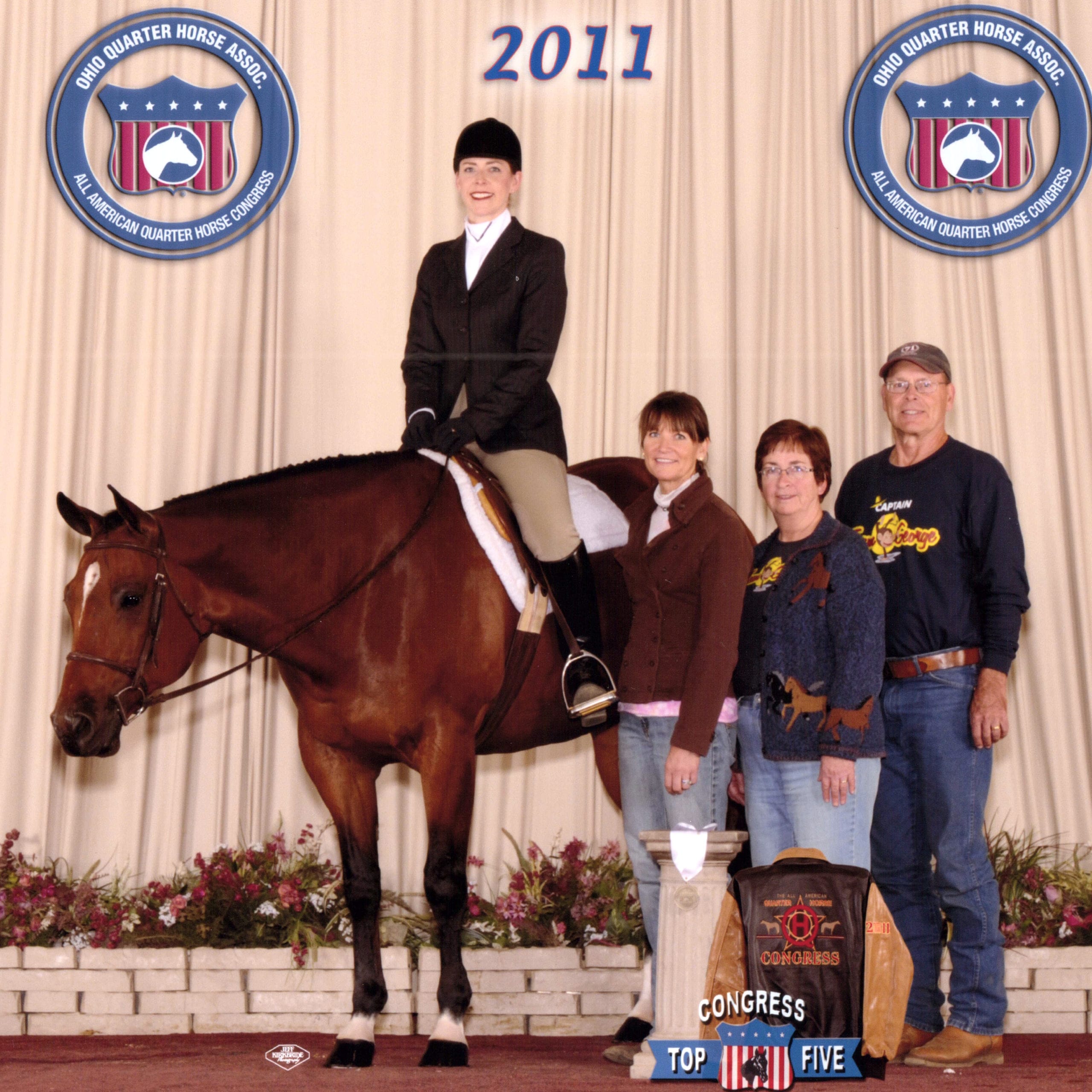Next up in our Congress Pattern series is Stephanie Lynn breaking down the 15-18 Youth Hunt Seat Equitation pattern. Lynn has been training, showing and coaching riders for over 30 years. She is a multiple World Champion and Congress Champion as well as having coached riders to wins at both shows. Her riders have won World and Congress Championships from Working Hunter and Pleasure Driving to Western Riding and Equitation, earning many All-Around titles along the way. She has judged the AQHA World Championship Show, All-American Quarter Horse Congress, the NSBA World Championship Show and most recently, the 2012 AQHA Youth World Championship Show.
We would also like to thank HorseShowPatterns.com for letting us post the pattern in the article. Please print out the pattern and follow along if that would be easier.
As far as why GoHorseShow chose the 15-18 Youth Equitation pattern, we wanted to breakdown the harder patterns due to the easier patterns having many of the same maneuvers.
Major Tips from Stephanie Lynn:
- The first thing that strikes me with this pattern is that there is a lot going on in a short amount of space. Any arena but Cooper will be large enough to present this pattern well, but the distance that the cones are set will be a major factor. Riders have many transitions to do within each line going into and out of each end of the serpentine.
- Another challenging issue for the riders coming out of the distance the cones will be set is to make the serpentine equal sided. By having a start cone and an end cone, the rider will have to judge this distance as they walk into the arena and prepare to ride their pattern. Riders will also have to dissect the pattern and find the line that divides the pattern in half. Riders will have to ride this line out of their first arc in order to make the serpentine be equal sided.
 Riders should take a look at the arena after the cones are set but before they ride into the arena to find the place in the arena (sign on the wall, mark on the wall, seat in the stands) that will be the focal point for the dividing line of the serpentine. Imagine you are following a chalk line just as the pattern is drawn and know where you are going to put your horse before you get there. Find markers in the arena to help determine a path.
Riders should take a look at the arena after the cones are set but before they ride into the arena to find the place in the arena (sign on the wall, mark on the wall, seat in the stands) that will be the focal point for the dividing line of the serpentine. Imagine you are following a chalk line just as the pattern is drawn and know where you are going to put your horse before you get there. Find markers in the arena to help determine a path.
- Breaking down the pattern, I love that it starts with a walk. That said, riders need to BE READY at the cone. There is no reason for a rider not to be nose to the cone and ready when the judges look up. Two horse lengths is enough room to get a smooth start and a nice soft transition into the trot. The walk should be a flat footed walk, not a jig that is the precursor to a trot. It is a simple maneuver but one that can be easily overlooked or rushed by an anxious rider hurrying into the trot.
- Move directly into the posting trot. A big strided horse may not have a lot of room to show the right diagonal and riders want to be sure to get four to five steps in before reaching cone B. Finding your diagonal goes without saying in this division. Do not look across the arena to locate cone B. Instead, use your peripheral vision to guide you into your diagonal change. You need to change your diagonal within the horse’s body length of the cone preferably right as the nose or shoulder passes the plane of cone B. The change will look late if you wait until the hip passes the plane.
- After changing your diagonal, trot one step in a straight line prior to starting the arc. The first end of your serpentine should be soft and round and equidistant to an imaginary point in the center of the arc. This is where you must find that line you decided on before you rode into the pen. Your eyes should be focused on the line your arc is to follow. At the top of the arc, your eyes should be on the line that divides the pattern in half (the sign on the wall, mark on the wall or seat in the stands). This is not an overly challenging part of the pattern so you want to make sure your serpentine is divided in half and the ends are even and smooth with no lopsided corner or overturns.
- After making the arc, and again using peripheral vision, pick up the right lead as your horse’s nose or shoulder passes the plane of cone B. This line needs to be straight so do not allow your horse to follow the direction of the lead or fade to the right – keep him or her cantering on a straight line. Remember this is a hunter class where it is expected that your horse canter, not lope. Keep the motion of the gait requested that which the class requires and in keeping with your horse’s ability.
- As you approach cone A change leads again keeping your horse straight through the lead change. Immediately after the lead change, riders should be in their two-point position with reins shortened. This is a pivotal part of the pattern. Up until this point, the pattern has been fairly straightforward with much opportunity for the judges to evaluate the rider’s position and equitation but without any real challenges.
- Immediately after the lead change, move directly into the two-point position and increase your pace. Your reins should be short enough to place your hands forward, about half way up the horse’s neck and held close to the horse’s neck, not up in the air. If through the course of riding the pattern, your reins have lengthened, shorten your rein as you move into the two-point and hand gallop. Again, you have a short distance to perform all of this so it is imperative that you are prepared. Know the line you are going to ride, follow the arc that you laid out prior to entering the arena and make sure that your reins are adjusted properly. A loose loopy rein is undesirable especially in a hand gallop.
- When your horse’s nose passes the plane of cone A, sit down, slow to a canter and continue on a straight line. You want to show a difference in pace here, not just a change in your position in the saddle. Make sure you show a change in pace prior to coming down to a sitting trot halfway to cone B. The fact that you are heading away from the gait should help in slowing down. However, do not let your horse simply wither at the end. Continue to ride strong to cone B. The sitting trot should be a working trot, not a western jog. Keep the same pace in your sitting trot throughout your trot – do not allow your horse to weaken or slow prior to your stop.
- Your stop should again be nose at the cone. Reins out of the stop should be low and in front of the pommel in the perfect place to ask your horse to back. Make sure you back one complete horse length. The turn on the forehand is to the right which will bring the hip back around toward the cone. You want to make sure you are clear of the cone and do not have to look down or back to make sure you are indeed clear of the cone.
- Exiting at the sitting trot toward the open gate, make sure that your horse stays in the trot by starting with just a bit of caution. Establish a slow trot step before asking for a working trot. You are no longer showing off here – simply exiting the pattern as written. Do not try to make a big impression here. Be safe and exit as asked.
*Stay tuned for the break down of the Congress Showmanship pattern with AQHA Judge Tina Anderson.







